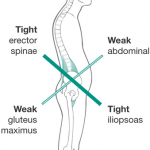 If I were a betting woman, I’d bet a pretty good sum that you’ve never heard anyone complain that their butt muscles were too tight. Or that their back muscles were just too darn loose. Coincidence? Au contraire, mon frere. It’s by design.
If I were a betting woman, I’d bet a pretty good sum that you’ve never heard anyone complain that their butt muscles were too tight. Or that their back muscles were just too darn loose. Coincidence? Au contraire, mon frere. It’s by design.
While the broader concept of muscle imbalances certainly generates a lot of buzz these days [even in the YFH Blog: Minimize Muscle Imbalances], there’s one significant aspect getting far too little attention. It’s the concept of postural and phasic muscles.
The terms describe two categories of muscles, defined by their distinct functions and properties. Postural muscles (e.g. spinal muscles, hip flexors, calves) are those most involved in maintaining our upright posture, while phasic muscles (e.g. glutes, deltoids, triceps, abdominals) are more responsible for moving us. But the more salient distinction is that postural muscles are programmed to become hyperactive, tight, and as a result, painful at times; whereas, phasic muscles are prone to become inhibited and weak. You can see how these divergent tendencies naturally predispose you to imbalances. In other words, by your body’s inherent design, muscle imbalances are the default–the rule not the exception. And they have major implications…
Consider which muscles you’re more prone to complain of being tight and/or painful: calves, pectorals (chest), low back, upper trapezius (upper back/back of neck)? And guess what they all have in common. Yep–all postural muscles. And the muscles you can’t ever seem to strengthen enough: glutes (butt), lower trapezius (mid-back between shoulder blades), abdominals? All phasic. These aren’t complete lists, but these examples pertain to the most common problems like shoulder rotator cuff injuries, neck pain, and low back pain.
Another important consequence of the postural/phasic divide: it can throw off your body’s delicate mechanics, making you more prone to injuries. Though the details are too involved for this post, this issue is a major culprit in all of the ailments mentioned above. Fortunately, knowing the details isn’t as crucial as simply understanding the need to address what are very predictable deficiencies of the major postural and phasic muscles.
So when you think “balanced workout,” don’t just think front to back and side to side. Think postural versus phasic and then focus on stretching the former and strengthening the latter. You don’t have to worry about making your back muscles too loose or your butt too strong. And I definitely wouldn’t take that bet if I were you.

4 Comments
2 Pings & Trackbacks
Pingback: FH Tip: Muscle Not Doing Its Job? Wake It Up! |
Pingback: FH Tip: A Good Way to Fit in Your Core Work |